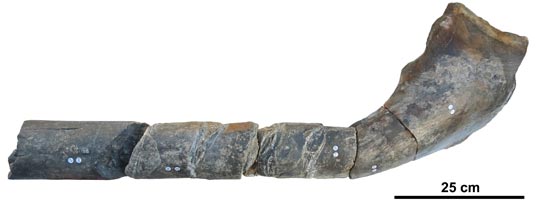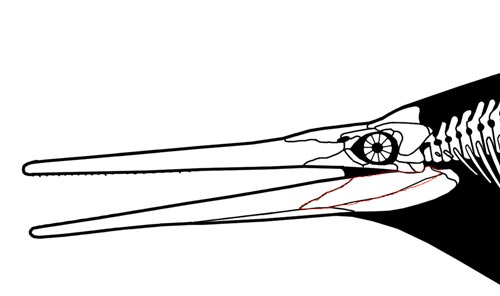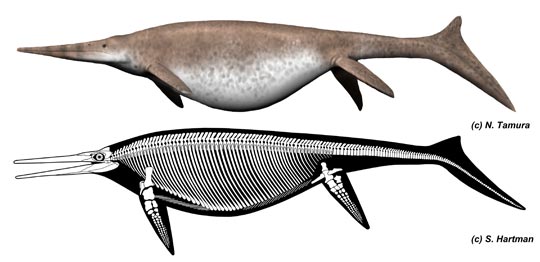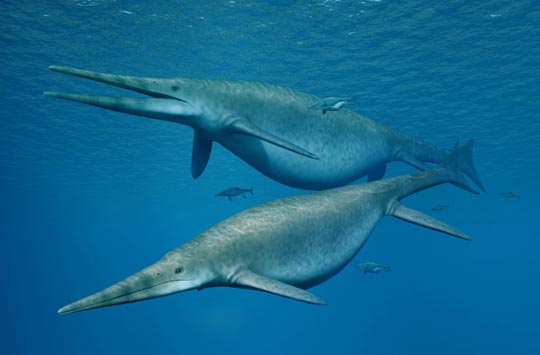Scientists Identify Giant Triassic Ichthyosaur Jaw Bone and Help Solve 19th Century Fossil Mystery
Scientists have identified a jaw bone of a giant marine reptile, that could represent one of the largest animals that ever lived. The newly described fossil bones, representing a portion of an enormous lower jaw, may also have shed light on a mystery that dates back to the middle of the 19th century. The fossilised jaw, which consists of several, broken, individual pieces, is thought to be an incomplete surangular (bone from the rear of the lower jaw), from a shastasaurid ichthyosaur, a clade of enigmatic, giant marine reptiles that were geographically widespread during the Late Triassic.
The fossil material was found on the beach at the small village of Lilstock in (west Somerset), the specimen is approximately 205 million years old.
A Lateral View of the Fossil Material – A Giant Ichthyosaur from Somerset!

Picture credit: Manchester University
Ichthyosaur Fossil Found on a Somerset Beach
Fossil collector and co-author of the study, published in the scientific journal PLOS One, Paul de la Salle, found a portion of the specimen in May 2016. He later returned to the beach and found more pieces, that together form a partial surangular more than a metre in length (see photograph above).
An Approximate Representation of the Location of Surangular on the Skull of Shonisaurus

Picture credit: Scott Hartman with additional annotation by Everything Dinosaur
Commenting on his fossil find Paul stated:
“Initially, the bone just looked like a piece of rock but, after recognising a groove and bone structure, I thought it might be part of a jaw from an ichthyosaur and immediately contacted ichthyosaur experts Dean Lomax (Manchester University) and Professor Judy Massare (SUNY College at Brockport, New York, USA), who expressed interest in studying the specimen. I also contacted Dr Ramues Gallois, a geologist who visited the site and determined the age of the specimen stratigraphically.”
Comparisons with Shonisaurus sikanniensis
Dean Lomax and Judy Massare made the surangular identification and visited the Royal Tyrrell Museum of Palaeontology in Drumheller, southern Alberta (Canada), to view skull material from the largest ichthyosaur yet described, the monstrous shastasaurid Shonisaurus sikanniensis. S. sikanniensis fossils come from Upper Triassic rocks found in British Columbia and the Royal Tyrrell material indicates a marine reptile around 21 metres in length. The researchers found similarities between the new Somerset specimen and Shonisaurus sikanniensis, which suggests that the Lilstock fossils represent a giant shastasaurid too.
A Life Restoration and Skeletal Drawing of the Giant Ichthyosaur Shonisaurus

Picture credit: Nobumichi Tamura and Scott Hartman
Ichthyosaur as Big as a Blue Whale?
Commenting on the approximate size of the Somerset specimen, Dean Lomax said:
“As the specimen is represented only by a large piece of jaw, it is difficult to provide a size estimate, but by using a simple scaling factor and comparing the same bone in S. sikanniensis, the Lilstock specimen is about 25% larger. Other comparisons suggest that the Lilstock ichthyosaur was at least 20 to 25 metres. Of course, such estimates are not entirely realistic because of the differences between species. Nonetheless, simple scaling is commonly used to estimate size, especially when comparative material is scarce.”
When compared to giant marine vertebrates today, the upper end of the size estimate for the Lilstock specimen would indicate a creature longer than the largest toothed whale, the Sperm whale (Physeter macrocephalus), indeed, at around 25 metres long, it would rival in size the largest cetaceans of all, adult Blue whales (Balaenoptera musculus).
A Pair of Giant Shastasaurid Ichthyosaurs Cruise the Late Triassic Ocean with a Pod of Smaller Ichthyosaurs for Company

Picture credit: Nobumichi Tamura
Solving a Mystery That Dates Back to 1850
In 1850, a large bone was described from the Upper Triassic sediments of Aust Cliff in Gloucestershire (UK). Four other fragmentary bone elements were subsequently found and described. Sadly, two of these fossils are missing and presumed destroyed. These bone shafts have been assigned to limb bones of herbivorous dinosaurs. Two of the fossils were thought to resemble the limbs of stegosaurs, but if that was the case, it would push back the evolutionary origins of stegosaurs into the Norian faunal stage of the Late Triassic. Other scientists have speculated that the fossil material might not be dinosaurian at all, but fossils of a related archosaur from the pseudosuchian lineage.
However, with the discovery of the Lilstock specimen, another possibility has come to light. These fossils could represent jaw fragments of giant, previously unrecognised ichthyosaurs, after all, the Aust Cliff location has already yielded a number of marine reptile fossils including ichthyosaurs.
Dean Lomax added:
“One of the Aust bones might also be an ichthyosaur surangular. If it is, by comparison with the Lilstock specimen, it might represent a much larger animal. To verify these findings, we need a complete giant Triassic ichthyosaur from the UK – a lot easier said than done!”
Visit the website of Dr Dean Lomax: Palaeontologist Dr Dean Lomax.
The scientific paper: “A Giant Late Triassic Ichthyosaur from the UK and a Reinterpretation of the Aust Cliff “Dinosaurian” Bones by Lomax, D. R., De la Salle, P., Massare, J. A. and Gallois, R. (2018) published in PLOS One.
Visit the award-winning Everything Dinosaur website: Everything Dinosaur.






Leave A Comment